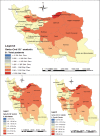Spatial analysis of myocardial infarction in Iran: National report from the Iranian myocardial infarction registry
- PMID: 26487871
- PMCID: PMC4590197
- DOI: 10.4103/1735-1995.163955
Spatial analysis of myocardial infarction in Iran: National report from the Iranian myocardial infarction registry
Abstract
Background: Myocardial infarction (MI) is a leading cause of mortality and morbidity in Iran. No spatial analysis of MI has been conducted to date. The present study was conducted to determine the pattern of MI incidence and to identify the associated factors in Iran by province.
Materials and methods: This study has two parts. One part is prospective and hospital-based, and the other part is an ecological study. In this study, the data of 20,750 new MI cases registered in Iranian Myocardial Infarction Registry in 2012 were used. For spatial analysis in global and local, spatial autocorrelation, Moran's I, Getis-Ord, and logistic regression models were used. Data were analyzed by Stata software and ArcGIS 9.3.
Results: Based on autocorrelation coefficient, a specific pattern was observed in the distribution of MI incidence in different provinces (Moran's I: 0.75, P < 0.001). Spatial pattern of incidence was approximately the same in men and women. MI incidence was clustering in six provinces (North Khorasan, Yazd, Kerman, Semnan, Golestan, and Mazandaran). Out of the associated factors with clustered MI in six provinces, temperature, humidity, hypertension, smoking, and body mass index (BMI) could be mentioned. Hypertension, smoking, and BMI contributed to clustering with, respectively, 2.36, 1.31, and 1.31 odds ratio.
Conclusion: Addressing the place-based pattern of incidence and clarifying their epidemiologic dimension, including spatial analysis, has not yet been implemented in Iran. Report on MI incidence rate by place and formal borders is useful and is used in the planning and prioritization in different levels of health system.
Keywords: Myocardial infarction; spatial analysis; spatial epidemiology.
Conflict of interest statement
Figures
Similar articles
-
Spatial analysis of mortality rate of pedestrian accidents in Iran during 2012-2013.Traffic Inj Prev. 2019;20(6):636-640. doi: 10.1080/15389588.2019.1628223. Epub 2019 Jul 8. Traffic Inj Prev. 2019. PMID: 31283359
-
Epidemiological pattern of myocardial infarction and modelling risk factors relevant to in-hospital mortality: the first results from the Iranian Myocardial Infarction Registry.Kardiol Pol. 2015;73(6):451-7. doi: 10.5603/KP.a2014.0230. Epub 2014 Nov 27. Kardiol Pol. 2015. PMID: 25428813
-
Integration of Moran's I, geographically weighted regression (GWR), and ordinary least square (OLS) models in spatiotemporal modeling of COVID-19 outbreak in Qom and Mazandaran Provinces, Iran.Model Earth Syst Environ. 2023 Feb 15:1-15. doi: 10.1007/s40808-023-01729-y. Online ahead of print. Model Earth Syst Environ. 2023. PMID: 36820101 Free PMC article.
-
Exploring spatial autocorrelation of traffic crashes based on severity.Injury. 2017 Mar;48(3):637-647. doi: 10.1016/j.injury.2017.01.032. Epub 2017 Jan 19. Injury. 2017. PMID: 28126318 Review.
-
Estrogen and progestin components of oral contraceptives: relationship to vascular disease.Contraception. 1997 May;55(5):267-72. doi: 10.1016/s0010-7824(97)00029-2. Contraception. 1997. PMID: 9220222 Review.
Cited by
-
Risk factors for heart failure in a cohort of patients with newly diagnosed myocardial infarction: a matched, case-control study in Iran.Epidemiol Health. 2016 May 17;38:e2016019. doi: 10.4178/epih.e2016019. eCollection 2016. Epidemiol Health. 2016. PMID: 27188309 Free PMC article.
-
Predictive Factors of Hospital Mortality Due to Myocardial Infarction: A Multilevel Analysis of Iran's National Data.Int J Prev Med. 2015 Nov 19;6:112. doi: 10.4103/2008-7802.170026. eCollection 2015. Int J Prev Med. 2015. PMID: 26730342 Free PMC article.
-
Modeling of the relationship between the environmental air pollution, clinical risk factors, and hospital mortality due to myocardial infarction in Isfahan, Iran.J Res Med Sci. 2015 Aug;20(8):757-62. doi: 10.4103/1735-1995.168382. J Res Med Sci. 2015. PMID: 26664423 Free PMC article.
-
Modeling of in hospital mortality determinants in myocardial infarction patients, with and without stroke: A national study in Iran.J Res Med Sci. 2016 Sep 1;21:74. doi: 10.4103/1735-1995.189687. eCollection 2016. J Res Med Sci. 2016. PMID: 27904619 Free PMC article.
-
Spatial environmental factors predict cardiovascular and all-cause mortality: Results of the SPACE study.PLoS One. 2022 Jun 24;17(6):e0269650. doi: 10.1371/journal.pone.0269650. eCollection 2022. PLoS One. 2022. PMID: 35749347 Free PMC article.
References
-
- Ahmadi A, Soori H, Mehrabi Y, Etemad K, Samavat T, Khaledifar A. Incidence of acute myocardial infarction in Islamic Republic of Iran: A study using national registry data in 2012. East Mediterr Health J. 2015;21:5–12. - PubMed
-
- Ahmadi A, Soori H, Sajjadi H. Modeling of in hospital mortality determinants in myocardial infarction patients, with and without type 2 diabetes, undergoing pharmaco-invasive strategy: The first national report using two approaches in Iran. Diabetes Res Clin Pract. 2015;108:216–22. - PubMed
-
- Ahmadi A, Soori H, Mobasheri M, Etemad K, Khaledifar A. Heart failure, the outcomes, predictive and related factors in Iran. J Mazandaran Univ Med Sci. 2014;24:180–8.
-
- Dégano IR, Elosua R, Marrugat J. Epidemiology of acute coronary syndromes in Spain: Estimation of the number of cases and trends from 2005 to 2049. Rev Esp Cardiol (Engl Ed) 2013;66:472–81. - PubMed
LinkOut - more resources
Full Text Sources
Other Literature Sources



